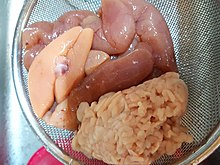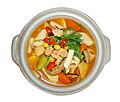Pollock roe, also pollack roe (also known as myeongnan and tarako) is the roe of Alaska pollock (Gadus chalcogrammus) which, despite its name, is a species of cod. Salted pollock roe is a popular culinary ingredient in Korean, Japanese, and Russian cuisines.
| Alaska pollock roe | |||||||
|---|---|---|---|---|---|---|---|
 | |||||||
| Korean name | |||||||
| Hangul | 명란 | ||||||
| Hanja | 明卵 | ||||||
| Literal meaning | Alaska pollock roe | ||||||
| |||||||
| Japanese name | |||||||
| Kanji | 鱈子 | ||||||
| Kana | たらこ | ||||||
| |||||||
| Russian name | |||||||
| Russian | икра минтая | ||||||
| Romanization | ikra mintaya | ||||||
Names
The purely Korean name for pollock, myeongtae had been assigned the Chinese character form 明太, which can be read as mentai in Japanese. But while the Japanese borrowed this name from Korean and called it mentaiko,[1] the term does not retain the originally meaning of plain raw roe, but specifically refers the chili pepper-added cured roe, while salt-cured only types are called tarako.[1][2][3]
Korean
As aforementioned, Alaska pollock in Korean is myeongtae (명태,明太), hence pollock roe is myeongnan (명란,明卵), a contracted form of the compound with +ran or +nan (란,卵) meaning "egg (roe)".
The salted roe dish is called myeongnan-jeot (명란젓), being considered a type of jeot (젓) or jeotgal, which is a category of salted seafood.
Japanese
In Japanese, (salted) pollock roe is called tarako (鱈子),[2][3] though it literally means 'cod roe',[a] while true cod roe is distinguished by calling it hontarako.[4][5] The pollock roe, also known as momijiko, are usually salted and dyed red.[4][5][b]
Pollock roe cured with red chili pepper are 明太子 (mentaiko);[5][2] to put it another way, mentaiko refers to chili-laced versions of tarako, generally speaking,[1] even if not qualified as karashi-mentaiko with the prefix meaning 'chili'.[c]
Russian
In Russian, pollock roe is called ikra mintaya (икра минтая). The word is also used to referred to the salted roe. The Russian word ikra (икра) means "roe" and mintaya (минтая) is the singular genitive form of mintay (минтай), which means Alaska pollock. The word is also derived from its Korean cognate, myeongtae (명태).
History
Korea
Koreans have been enjoying pollock roe since the Joseon era (1392–1897). One of the earliest mentions are from Diary of the Royal Secretariat, where a 1652 entry stated: "The management administration should be strictly interrogated for bringing in pollock roe instead of cod roe."[6] Recipe for salted pollock roe is found in a 19th-century cookbook, Siuijeonseo.
Japan
A 1696 Japanese book records the use of Alaska pollock's roe in Northern land.[7]
The dish mentaiko originates from Korea, but after more than 100 years of modification, most of the pollack roe consumed in Japan is Japanese mentaiko.[8][9][10][11][12][13][14] Toshio Kawahara (川原 俊夫, Kawahara Toshio), who was born in the city of Busan, Korea during the Japanese occupation, founded the oldest mentaiko company in Japan called "Aji no Mentaiko Fukuya" (ja:ふくや) after World War II. He made several modifications to myeongnan-jeot to adapt to Japanese tastes and introduced it to Japan as "Karashi mentaiko" (ja:辛子明太子), its popular name is "mentaiko". The milder, less spicy version is called tarako (鱈子) in Japan. Eventually, Mentaiko is quite different from Korean myeongnan-jeot, and so much more is consumed. And Japan's mentaiko is also imported back to Korea.[8]
Consumption
 | |
| Alternative names | Myeongnan Myeongnan-jeot Tarako Mentaiko Ikra mintaya |
|---|---|
| Type | Jeotgal |
| Course | Banchan |
| Place of origin | Korea |
| Associated cuisine | Korean cuisine Japanese cuisine Russian cuisine |
| Main ingredients | Roe of Alaska pollock |
| Salted Alaska pollock roe | |||||||
|---|---|---|---|---|---|---|---|
| Korean name | |||||||
| Hangul | 명란젓 | ||||||
| Hanja | 明卵- | ||||||
| Literal meaning | Alaska pollock roe jeotgal | ||||||
| |||||||
| Japanese name | |||||||
| Kanji | 鱈子/(辛子)明太子 | ||||||
| Kana | たらこ/(からし)めんたいこ | ||||||
| |||||||
| Russian name | |||||||
| Russian | икра минтая | ||||||
| Romanization | ikra mintaya | ||||||
Korea
Traditionally, myeongnan-jeot was made before dongji (winter solstice). Intact skeins of Alaska pollock roe are washed carefully with salt water, then salted in a sokuri (bamboo basket). The ratio of salt to roe ranges from less than 5:100 to more than 15:100. After 2–3 days, salted and drained roe is marinated for at least a day with fine gochutgaru (chilli powder) and finely minced garlic. myeongnan-jeot is usually served with sesame seeds or some drops of sesame oil.
Myeongnan-jeot, whether raw, dried, and/or cooked, is a common banchan (side dish) and anju (food served with alcoholic beverages). It is also used in a variety of dishes, such as gyeran-jjim (steamed egg), bokkeum-bap (fried rice), and recently in Korean-style Italian pasta dishes.
Myeongnan-jeot is a specialty of South Hamgyong Province of North Korea, and Gangwon Province and Busan of South Korea.
- Myeongnan-jeot sold in a market
- Vacuum-packed myeongnan-jeot
- Heavily seasoned myeongnan-jeot
- Myeongnan-jeot-muchim (salted pollock roe salad)
- Myeongnan-jeot-gyeran-mari (rolled omelette with salted pollock roe)
- Myeongnnan-jeot in jjigae (stew)
- Myeongnan-jeot pizza
Japan
Mentaiko, adapted from Korean myeongnan-jeot,[9][10][11][12][13][14] hence the name mentai (derived from the Korean myeongtae, 명태, 明太, meaning pollack) + ko (Korean 알, 子, meaning baby/roe), is common in Japan. It is made in a variety of flavors and colors and is available at airports and main train stations. It is usually eaten with onigiri, but is also enjoyed by itself with sake. A common variety is spicy mentaiko (辛子明太子, karashi mentaiko). It is a product of the Hakata ward of Fukuoka City. Milder version is called tarako (鱈子),
Recently in Japan, mentaiko pasta has become common. Mentaiko is mixed with butter or mayonnaise and used as a sauce for spaghetti. Thin strips of Nori (海苔) and Shiso leaves are often sprinkled on top.
Mentaiko was nominated as Japan's number one side dish in the Japanese weekly magazine, Shūkan Bunshun.[15]
Tarako is served in a number of ways: plain (usually for breakfast),[16] as a filling for onigiri, and as a pasta sauce (usually with nori). Traditionally, tarako was dyed bright red, but recent concerns about the safety of food coloring have all but eliminated that custom.[16] In Kyūshū, tarako is commonly served with red chili pepper flakes.
Russia
In Russia, pollock roe is consumed as a sandwich spread. The product, resembling liquid paste due to the small size of eggs and oil added, is sold as canned food.
As mentioned above, in Russian, the word for pollock roe is the same as for the caviar: "ikra". The same goes to a dish, known to the French as "caviar d'aubergine": "кабачковая икра", although it's a spread made of eggplants.
To make the pollock roe taste in a caviar-like way, one should make a butterbrot first e.g. to apply butter to the bread before adding the canned pollock roe. This will smoothen the excessive saltiness of the canned roe.
- An open sandwich with canned roe
- A piece of similar bread with less roe used since Ikra mintaya (canned roe) is rather salty.
See also
Explanatory notes
References
External links
 Media related to Pollock roe at Wikimedia Commons
Media related to Pollock roe at Wikimedia Commons

















